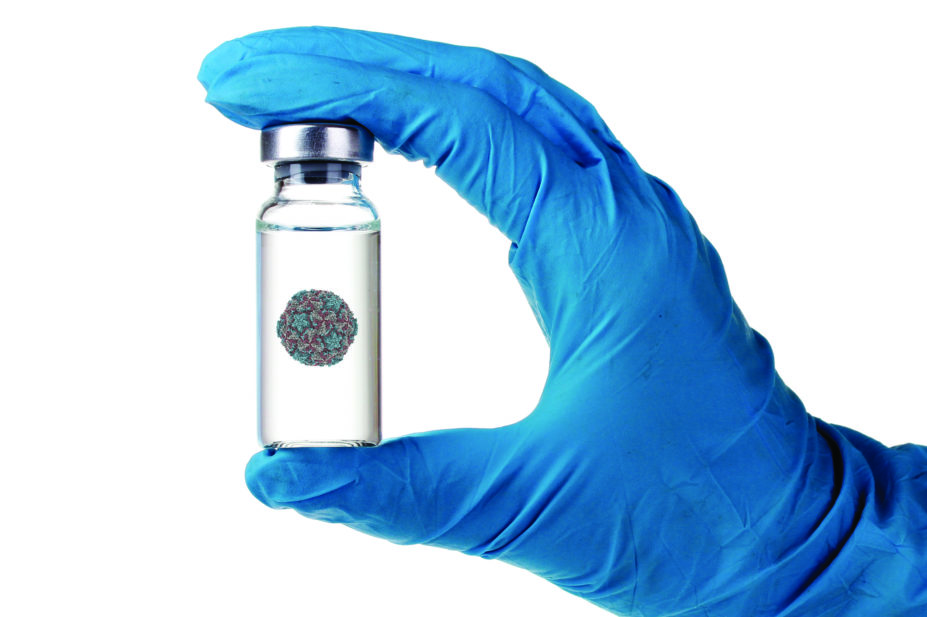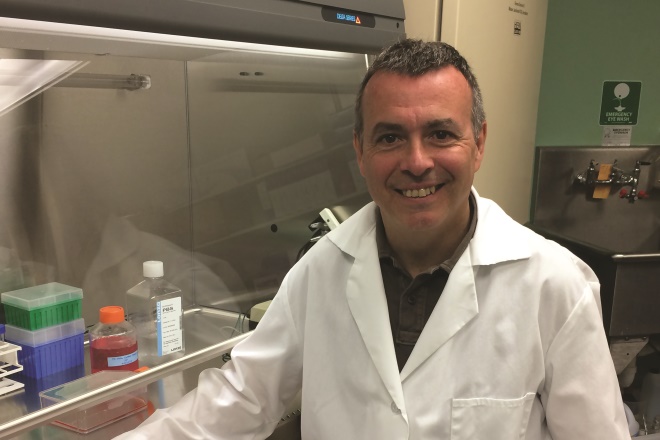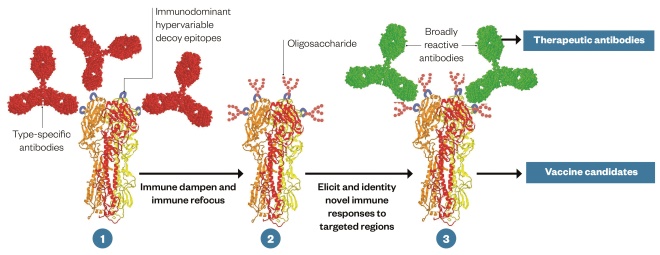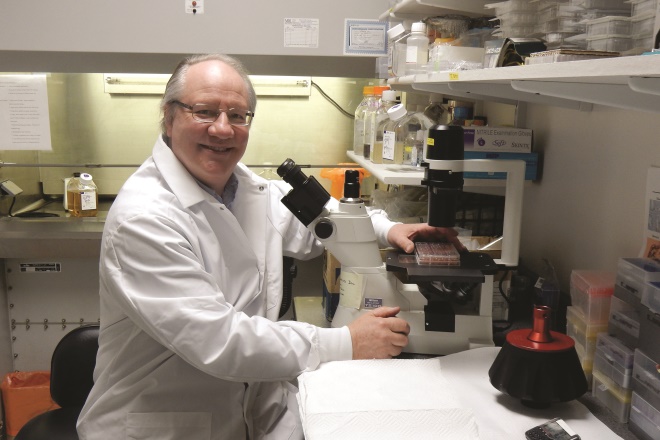
Shutterstock / Laguna Design/Science Photo Library
The researchers working on a vaccine for rhinovirus, the infection that causes the common cold, are all clear on one important point — they’re not trying to cure the sniffles.
“Rhinovirus is more than just a nuisance,” says Martin Moore, a virologist at Emory University in Atlanta, Georgia. “Sniffles in adults are not why we are doing this.”
While the virus causes mild symptoms in most people and is considered a minor annoyance, it can cause severe problems in young children with asthma, and elderly people with pneumonia or chronic obstructive pulmonary disease (COPD).
Rhinoviruses usually cause upper respiratory tract infections, but in people with underlying lung diseases the increased inflammation tends to affect the lower respiratory tract, says Gary McLean, an immunologist at Imperial College London. Inflammation causes breathing difficulty; the illness lasts longer and can be much more serious. In children, colds are a major cause of asthma attacks, and having a large number of colds at a young age is a good predictor that a child will go on to develop asthma.
James Gern, an allergist at the University of Wisconsin in Madison, Wisconsin, says it is not yet clear whether rhinovirus causes asthma, or if people with asthma are particularly susceptible to the virus, but he thinks it is reasonable to suspect a causal relationship. “If a child gets lower airway infections over and over, it could cause scarring in their growing lungs,” he says. Gern’s long-running longitudinal study of children born in Madison has been instrumental in uncovering the prevalence and complications of rhinovirus infections among children. He found that rhinovirus infections are “nearly universal” among children with asthma during cold season, and the associated illnesses lasted longer and were more severe in those children[1]
.

Source: Courtesy of James Gern
James Gern, allergist at the University of Wisconsin in Madison, Wisconsin, found that rhinovirus infections are “nearly universal” among children with asthma during cold season, and the associated illnesses lasted longer and were more severe in those children.
We’re not trying to cure the common cold, but alleviate the symptoms of severe, acute lung diseases
A vaccine is needed because for people at risk of complications from rhinovirus, “there’s no treatment except to put them in the hospital and hope they get better”, says McLean. “We’re not trying to cure the common cold, but alleviate the symptoms of severe, acute lung diseases.”
The hurdles
Developing a vaccine, however, has proved difficult. “It’s a tricky one, the pathogen doesn’t make it easy,” says McLean.
The biggest problem is the sheer number of rhinoviruses. So far, at least 160 different serotypes have been identified across three different species known as A, B, and C. The C viruses, now numbering around 60 serotypes, were discovered only ten years ago[2]
. That profusion of serotypes is a problem because while the human immune system is good at producing antibodies to protect us from any one individual strain of the virus after exposure, that protection does not extend across different serotypes.
Having a vaccine that can protect against all or most of the serotypes out there is important because, unlike with influenza where the strains likely to dominate each year are known and vaccines can be tailored to match, there are no particular strains of rhinovirus that dominate — they co-circulate throughout the world. “With rhinovirus we can’t narrow it down,” says Jorge Blanco, president of Sigmovir Biosystems, a biotech company based in Rockville, Maryland. “We have to work with the assumption that every serotype is prevalent.”

Source: Courtesy of Jorge Blanco
Jorge Blanco, president of Sigmovir Biosystems, a biotech company based in Rockville, Maryland, says that animal models are needed to prove the vaccine can be effective.
The lack of a good animal model to test vaccine candidates in vivo is also hampering progress. Antibodies that neutralise the virus in a petri dish may not always work in living systems, and some antibodies that only appear to work for one serotype in vitro may actually show cross-serotype action when tested in vivo. “Animal studies are needed to prove the vaccine can be effective,” says Blanco, whose company is working on a rhinovirus model using the cotton rat. So far it has managed to grow two serotypes — RV14 and RV16 — in the rats.
There is activity in the field, but there have been so many failures, there aren’t many papers published
All these hurdles mean there has been little movement towards developing an effective rhinovirus vaccine since an initial burst of optimism in the 1970s. “There is activity in the field, but there have been so many failures, there aren’t many papers published,” says Greg Tobin, chief scientist at Biological Mimetics, based in Frederick, Maryland.
But things are starting to look up. Several different research groups are now making good progress on rhinovirus vaccines, using a variety of different techniques.
Old-school approach
Moore and his team at Emory are taking perhaps the simplest, most brute-force approach: cramming as many different serotypes as possible into one vaccine. “Our method is completely old school,” says Moore.
Multivalent vaccines are not new — the vaccine for polio, which, like rhinovirus, is a coronavirus, covers three serotypes, and the pneumococcal vaccine includes all 23 serotypes. But what Moore is suggesting is far beyond what anyone has attempted before. “Depending on the dose, I think we could make a 100-valent vaccine,” he predicts.

Source: Courtesy of Martin Moore
Martin Moore, a virologist at Emory University in Atlanta, Georgia, says the rhinovirus is so good at stimulating antibodies that only a tiny amount of each serotype will be needed in a vaccine.
Sticking with the old-school theme, Moore intends to use inactivated viruses and the well-understood processes used in making the vaccine for the related polio virus. The trick is finding a way to squeeze enough antigen into a reasonably small shot. It is not going to be easy. Including the C viruses is proving especially tricky, since they have only recently been cultured in cells, and so far researchers have not been able to grow them up to a high enough concentration to allow them to be diluted down to a small enough volume to include in a vaccine. “It’s going to take a lot of process research,” says Moore.
They are very immunologic particles, so we predict that a 100-valent vaccine would contain no more protein than the average flu shot
Once that kink is worked out, however, Moore says the virus is so good at stimulating antibodies that only a tiny amount of each serotype will be needed in a vaccine. “They are very immunologic particles, so we predict that a 100-valent vaccine would contain no more protein than the average flu shot,” he says.
Moore is now working with Meissa Vaccines in South San Francisco, California, on developing the manufacturing process, but predicts he is still more than two years away from human trials.
Synthetic epitopes
Other researchers are trying more complex methods to get the cross-serotype protection that a viable vaccine will need. Tobin is using a technique called immune refocusing technology to try and engineer a synthetic epitope — the part of the viral antigen that antibodies bind to — that will stimulate protection against multiple serotypes. Instead of being specific to a single strain, it will be a kind of generic antigen, whose antibodies will be able to recognise several different serotypes.

Figure 1: Immune refocusing technology
Source: Vaccine 2008;26:6189–6199
Immune refocusing technology is being used to try to engineer a synthetic epitope — the part of the viral antigen that antibodies bind to — that will dampen the immunogenicity of the strain-restricted antibody response and redirect immune stimulation towards more highly conserved epitopes that are normally immunologically silent. The figure above is using influenza haemagglutinin (HA) trimer as an example.
1. Native HA-containing immunodominant decoy epitopes induce type-specific antibodies;
2. The HA is engineered to include additional N-linked glycans at specific sites in the epitopes;
3. The immune refocused HA antigen elicits broadly reactive immune responses and can be used as a vaccine or to derive novel therapeutic antibodies that have broad reactivity.
“We ask ‘what amino acids do antibodies like’, and then gently modify the epitopes to change key amino acids to make an antigen that will stimulate cross-protective antibodies,” says Tobin of Biological Mimetics.

Source: Courtesy of Greg Tobin
Greg Tobin, chief scientist at Biological Mimetics, Maryland, is using immune refocusing technology to create a kind of generic antigen, whose antibodies will be able to recognise several different serotypes.
Every single immune-refocussed antigen has stimulated unprecedented cross-serotype antibodies
The company has had some success with this method so far. “Every single immune-refocussed antigen has stimulated unprecedented cross-serotype antibodies,” he says. The company’s leading vaccine candidate, known as M5, has neutralised 41 out of the 61 serotypes it has been tested against so far. And though M5 is based on an A virus, it neutralises B virus serotypes just as well.
“I never thought we’d get that good of a response,” says Tobin, who adds that he expects to see similar success against the C viruses once they develop a good way to test it. The company is aiming to start phase I and II human trials in 2018.
Back at Imperial College London, McLean is skeptical about how effective the synthetic epitopes will be in practice. “They may work in an experimental setting, but they are deviating from the native pathogen. So what happens when the immune system encounters a native strain?” he says.
Targeting capsid protein
McLean’s own work, like Tobin’s, is focused on making a single, cross-protective antigen. He and his colleagues searched the genomes of a variety of rhinovirus strains for highly conserved regions that they shared. They found several, but most were for proteins that stay within the viral envelope or the infected cell. A vaccine needs a target on the virus’s surface. Eventually, the group identified a protein called VP0 that forms part of the virus’s outer coating, or capsid, which is shared by more than 100 strains. “We thought it might be useful to immunise with that protein, and that could give us cross-serotype protection,” says McLean.

Source: Courtesy of Gary McLean
Gary McLean, an immunologist at Imperial College London, is focused on making a single, cross-protective antigen and his group has identified a protein called VP0 that forms part of the virus’s outer coating, which is shared by more than 100 strains.
But instead of trying to generate antibodies, McLean wants his vaccine to induce T cells that can recognise as many different strains as possible, and to train the immune system’s T cells to respond in a more appropriate way to rhinovirus infections. People with chronic lung diseases tend to mount the wrong kind of immune response to rhinovirus. They mount a TH2 response, which McLean describes as “a big dangerous mess” of inflammation, instead of the normal response to a viral infection, known as a TH1 response. By including an adjuvant known to produce a TH1 response, the vaccine lets the immune system know how it should react the next time the virus appears. Getting the body to produce that TH1 response will not only help clear the infection, but will also tone down the unhelpful TH2 inflammatory response that can trigger an asthma attack.
We want to skew the immune response back to a more favourable T-cell response
“We want to skew the immune response back to a more favourable T-cell response,” he says.
McLean says he is “a little bit away” from phase I human trials — the biggest challenge right now is finding an appropriate adjuvant, since the viral particles themselves don’t promote much of an immune response on their own. He also needs to show that his capsid protein can also produce results for the C viruses, which were discovered after he began this work. “To convince someone to provide the money for human trials, we’ll need to show it works for type C as well,” he says.
It’s not clear yet which of these techniques is likely to result in a successful human vaccine, but all three are worth pursuing, says Gern at the University of Wisconsin. “With 160 plus serotypes, any kind of virus is going to be a major challenge,” he says. “It makes sense to pursue multiple approaches.”
And the renewed interest in the field is starting to convince researchers and pharmaceutical companies that this underexploited area is a worthwhile place to put their efforts.
“Once if you said you were working on a common cold vaccine you risked getting laughed at,” says Tobin. “That’s starting to change.”
References
[1] Olenec JP, Kim WK, Lee WM et al. Weekly monitoring of children with asthma for infections and illness during common cold seasons. J Allergy Clin Immunol 2010;125:1001–1006.e1. doi: 10.1016/j.jaci.2010.01.059
[2] Lee WM, Kiesner C, Pappas T et al. A diverse group of previously unrecognized human rhinoviruses are common causes of respiratory illnesses in infants. PLoS ONE 2007;2):e966. doi: 10.1371/journal.pone.0000966


